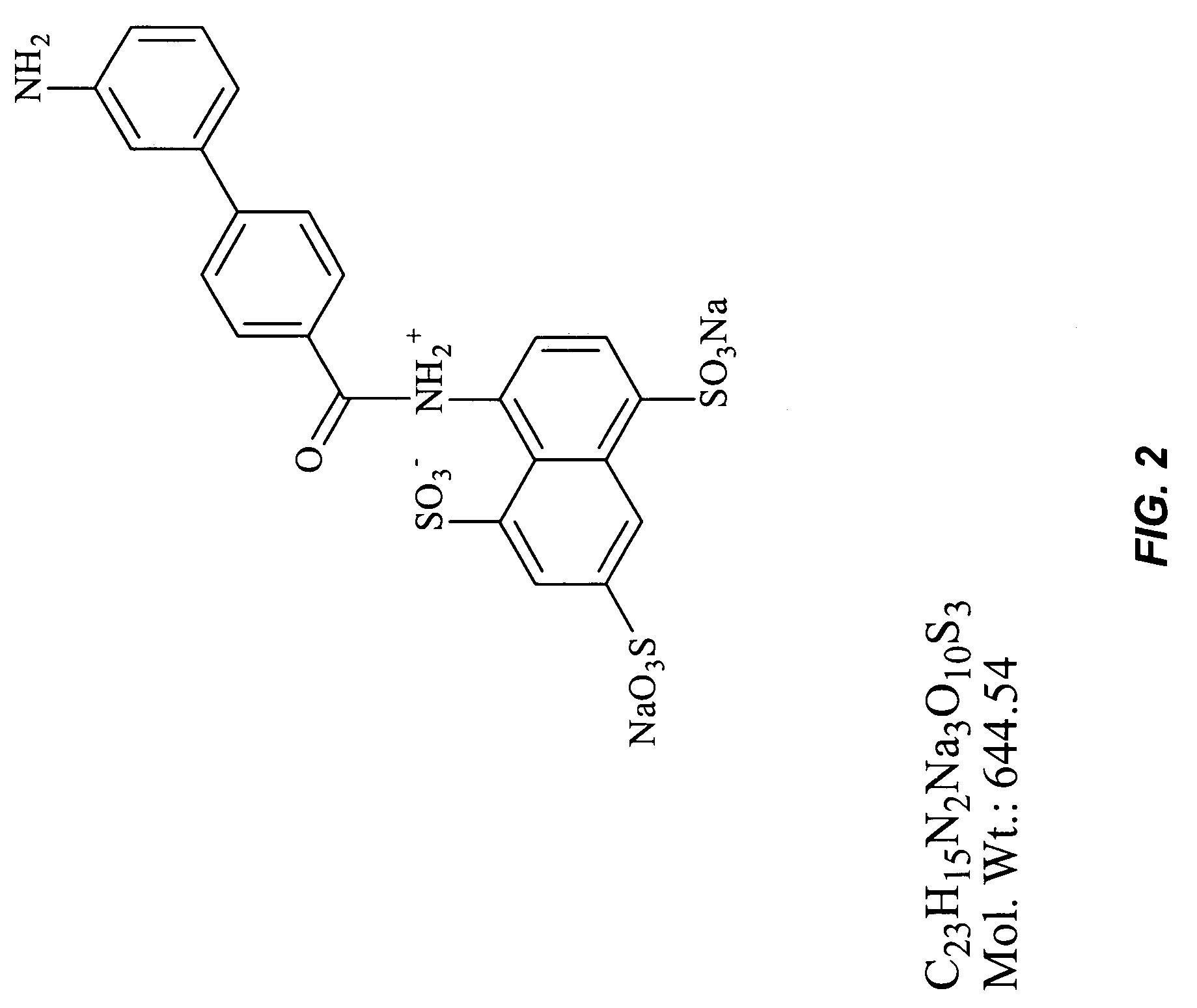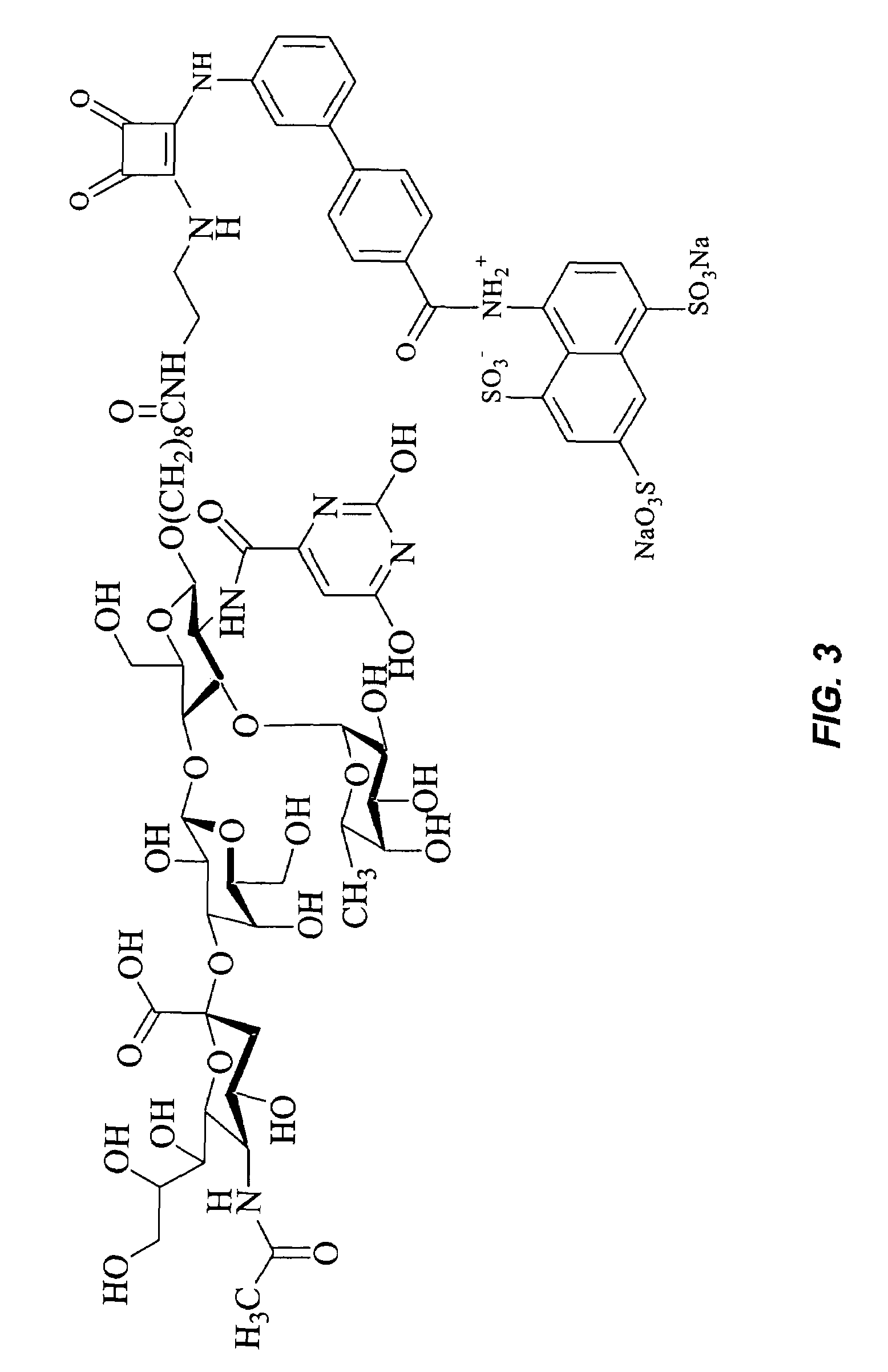Specific antagonist for both E- and P-selectins
a technology of p-selectin and specific antagonist, which is applied in the field of compounds, can solve the problems of tissue damage instead of repair, unsuitable for drug development,
- Summary
- Abstract
- Description
- Claims
- Application Information
AI Technical Summary
Problems solved by technology
Method used
Image
Examples
example 1
Preparation of a BASA (FIG. 4)
Suzuki Coupling
[0060]4-(4,4,5,5-Tetramethyl-[1,3,2]dioxaborolan-2-yl)-benzoic acid (0.004 mol, 1 eq) and KOAc (0.012 mol, 3 eq) are placed in THF (25 ml) creating a slurry. PdCl2(dppf) (0.00012 mol, 3 mol %) and p-bromo-nitrobenzene (0.005 mol, 1.2 eq) are then added to the solution with stirring and the solution is heated gently to 80° C. After 6 hrs the reaction is complete by TLC (20:1 CH2Cl2 / CH3OH). The reaction mixture is evaporated to dryness, dissolved in CH2Cl2 (30 ml) and washed with distilled water and saturated NaHCO3. The resultant biphenyl compound is taken directly to the next step.
Carbodiimide Coupling
[0061]4′-Nitro-biphenyl-4-carboxylic acid (0.004 mol, 1 eq), dimethyl amino pyridine (1 crystal, cat.) and EDCI (0.0041 mol, 1.05 eq) are dissolved in DMF (or THF, 20 ml) and allowed to react at room temperature for 10 min. 8-Amino-naphthalene-1,3,5-trisulfonic acid is added to the reaction mixture with stirring and the reaction is allowed t...
example 2
Synthesis of Glycomimetic with Squaric Acid Linker (FIG. 9)
Activated Ester Synthesis
[0063]Compound of FIG. 1 (1.8 μmol, 1 eq) is dissolved in 1,2-diaminoethane (50 μl, XS) with stirring. The solution is heated to 70° C. for 50 hrs under nitrogen. The solution is then evaporated to dryness and the compound is purified by reverse phase chromatography (C18 column, 80 / 20 CH3CN / H2O-1% TFA to 50 / 50 CH3CH / H2O).
Squarate Ester Formation
[0064]The amine (5.40 μmol, 1 eq) is dissolved in 0.1M Hepes buffer of pH 7 and reacted with squaric acid diethyl ester (80 μmol, XS) for 24 hrs. The solution is then washed with CH2Cl2 and the aqueous layer is collected and evaporated to dryness. The resultant powder is purified by column chromatography (Sephadex-G25, 100% H2O).
example 3
Synthesis of Glycomimetic-BASA (FIGS. 10A-10D)
Synthesis of Compound 12:
[0065]Starting from N-acetyl glucosamine (5, 50 g) compound 12 (50% overall yield) is synthesized following published procedure (Bioorg. Med. Chem. Lett. 11, 2001, 923-925; Carbohydr. Res. 197, 1990, 75).
Synthesis of Compound 17:
[0066]Compound 17 (15 g) is prepared from L-fucose following published procedure (Carbohydr. Res. 201, 1990, 15-30).
Synthesis of Compound 21:
[0067]Compound 21 is prepared from commercially available β-D-galactose-pentaacetate as described (WO 9701569; Chem. Astr. 1997, 126 186312).
Synthesis of Compound 25:
[0068]Commercially available N-acetyl neuraminic acid (22, 10 g) is suspended in MeOH—H2O (60 ml, 9:1), and the pH is adjusted to 8.1 by adding an aqueous solution of cesium carbonate. The solvent is removed, and the residue is repeatedly evaporated with ethanol and then with hexane. The material is dissolved in DMF (65 ml), and benzyl bromide (3.5 ml) is added within 20 min. After the m...
PUM
| Property | Measurement | Unit |
|---|---|---|
| pH | aaaaa | aaaaa |
| pH | aaaaa | aaaaa |
| volume | aaaaa | aaaaa |
Abstract
Description
Claims
Application Information
 Login to View More
Login to View More - R&D
- Intellectual Property
- Life Sciences
- Materials
- Tech Scout
- Unparalleled Data Quality
- Higher Quality Content
- 60% Fewer Hallucinations
Browse by: Latest US Patents, China's latest patents, Technical Efficacy Thesaurus, Application Domain, Technology Topic, Popular Technical Reports.
© 2025 PatSnap. All rights reserved.Legal|Privacy policy|Modern Slavery Act Transparency Statement|Sitemap|About US| Contact US: help@patsnap.com



